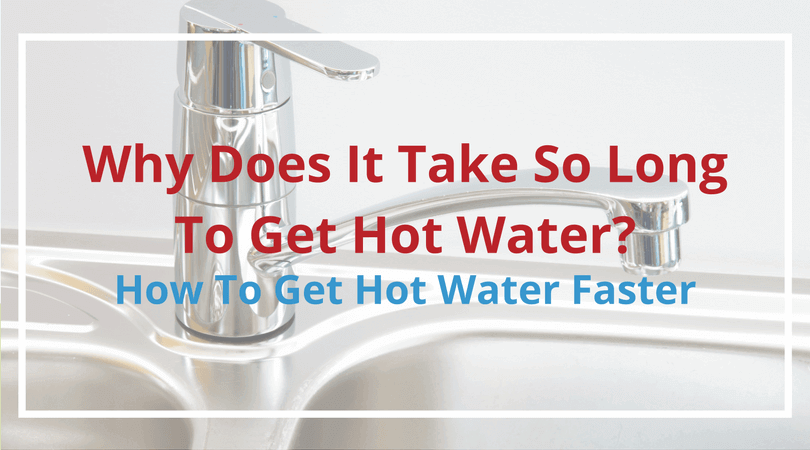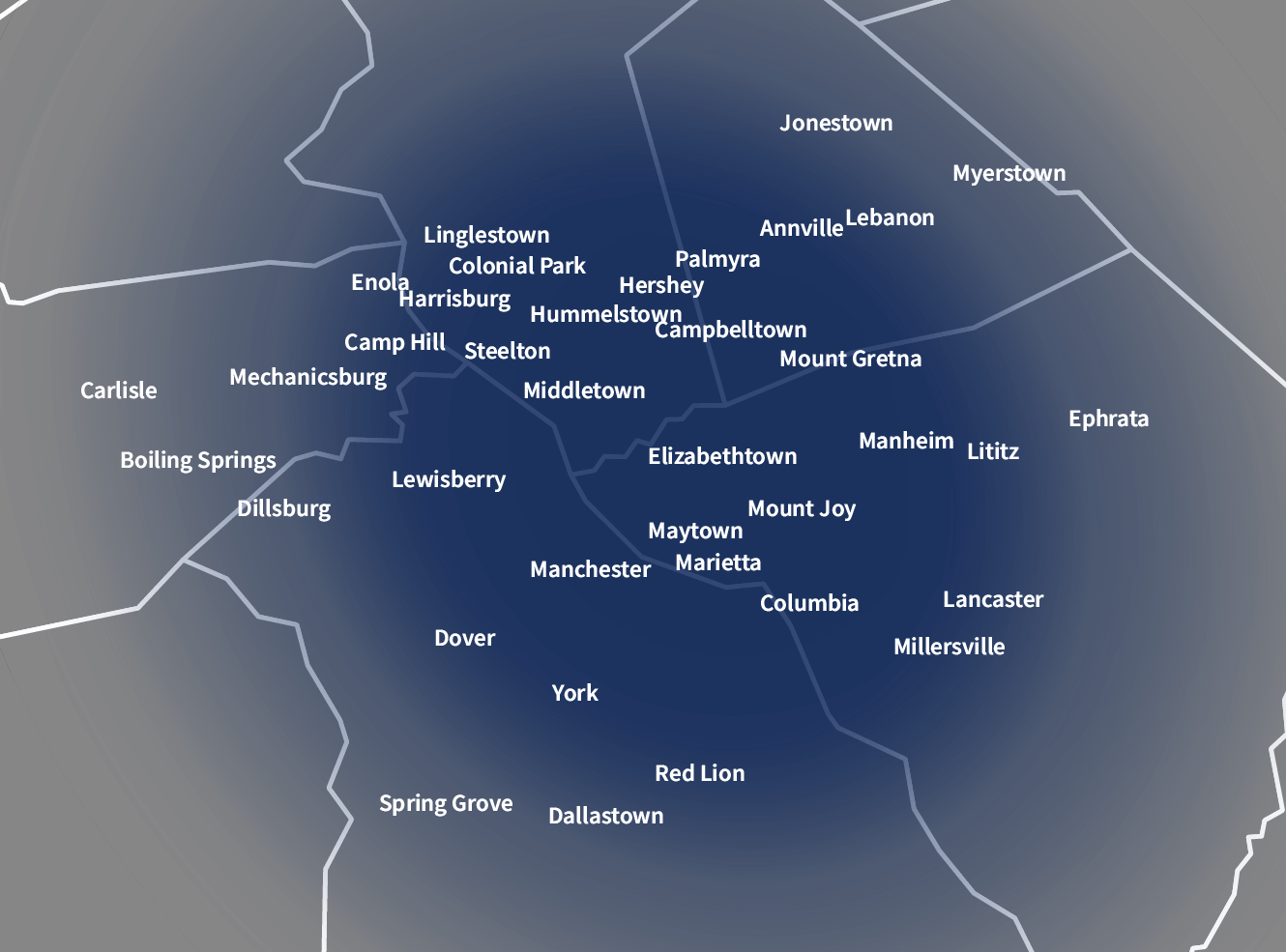Table of Contents – Jump To:
- Why Does it Take So Long To Get Hot Water (Video)
- Reasons it Takes so Long to Get Hot Water
- How to get Hot Water Faster
- 8 Solutions to Prevent Running Out of Hot Water
Why Does It Take So Long to Get Hot Water?
Waiting for hot water while washing your dishes or during your morning shower can be a time-consuming aspect of your long day. But what is causing the delay of hot water to your faucets? And more importantly, can you fix this problem and get hot water in a snap?
These questions are important since quick access to hot water isn’t just an issue of convenience. When you’re waiting for your water to travel from the hot water heater to your tap, you’re not just wasting time, you’re also wasting money. Let’s talk about some of the reasons hot water might take a long time to reach the taps and what you can do to get (nearly) instant hot water.
Reasons it Takes So Long for Hot Water
Before you can address the issue of slow hot water delivery, you need to know what the cause is. In many cases, a combination of factors can slow down the delivery of hot water.
1. Water Currently in Pipes
One of the most basic reasons many homeowners are forced to wait for hot water to come out of the faucet is that there’s water already in the pipes. Water starts flowing from the faucet as soon as you turn it on, and the water that comes out first won’t come directly from your hot water heater. Instead, the water that’s currently sitting in the pipes leading up to the faucet arrives first. That water might be chilly or room temperature.
2. Distance from Hot Water Heater
Another reason it can take a while for hot water to flow from a faucet is the water has to travel a considerable distance from your water heater to the sink, shower or tub. For example, if your water heater is located in the basement, it can take a relatively long time for hot water to get to the sink in your second-floor bathroom.
If hot water has to travel through dozens of yards of winding pipework before it reaches your fixture, cold water will flow while the hot water is making its way there. This can be an inconvenience that also results in wasted water.
3. Volume Restrictors
A volume, or flow, restrictor can also contribute to a hot water delay. Many fixtures, like your showerhead, are designed to have a low flow rate. Some have a volume restrictor installed. The purpose of these devices is to reduce the amount of water that comes through your fixture.
While these are great for conserving water and saving on costs, they can cause a delay in your water delivery. When water comes through at a slower rate, this can mean you have to wait longer for hot water. The delay can be more noticeable if you’re already dealing with another hot water issue, such as a long distance from the water heater in your home.
4. Malfunctioning Water Heater
If your water used to heat quickly, but now you’re noticing that it’s taking longer for hot water to get to your fixtures or you’re running out of hot water too soon, a malfunctioning water heater may be to blame. Most water heaters are made to last between eight and 12 years. If your water heater is nearing the end of its intended lifespan, it could have some difficulty doing its job or might breakdown completely.
If your water heater seems to be less effective than it used to be, you should call a service professional to come take a look at it and diagnose the problem. There may be a maintenance issue they can fix, or they may let you know it’s time to replace the heater.
learn more about Water heater services
5. Sediment Buildup
One problem that can compromise your water heater’s effectiveness is sediment buildup. The water that flows through our homes has minerals in it, such as calcium and magnesium. It’s normal for water to have some mineral content. However, some households have hard water, which contains more than 60 milligrams of dissolved minerals per liter of water.
Minerals can build up at the bottom of the heater’s tank, particularly in homes with hard water. As sediment builds up over time, it leaves little space for water in the tank. A tank with a reduced water capacity will run out of hot water more quickly than a tank that’s free of sediment.
6. Outside Temperature
Even if your hot water heater is working properly, it could still struggle to deliver a steady supply of hot water when it’s cold outside. If you live in an area such as the Northeast United States where winter means freezing temperatures, then you may have noticed this issue before. When the outside air is cold, the water that enters your home underground will also be cold.
This means your water heater has to work harder to get the water to the target temperature, typically 120 or 140 degrees Fahrenheit. Once the hot water starts to travel from your tank to a fixture in your home, it can be cooled down by cold pipes in your walls. You’re likely to experience cooling if your water has to travel a long distance from the tank.
7. Size and Thickness of Pipes
Finally, the water pipes in your home can contribute to the problem of hot water delivery. The diameter of the pipes might influence how long it takes hot water to come out of a faucet. Pipes that are larger in diameter hold more water, meaning it takes longer for hot water to get from point A to point B.
The thickness of the pipe’s wall also affects the quality of your hot water delivery. For metal pipes, the thicker the material, the more the pipe walls are capable of pulling heat from the water as it makes its way through the pipe. If you have galvanized pipes, which are thicker than copper pipes, you might notice your water cools off on its way to your fixture.
How to Get Hot Water Faster
Now that we’ve covered some common causes for a delay in hot water, let’s talk about what you can do to get hot water faster in the shower and at the kitchen sink. Thankfully, there are several solutions you can try.
1. Insulate the Pipes
If you think your water pipes are to blame for your hot water troubles, adding insulation might improve your situation. Insulating your pipes will help warm them and keep the heat in so they can more effectively deliver hot water. According to the U.S. Department of Energy, insulated pipes can keep the temperature of the water inside two to four degrees higher than non-insulated pipes.
Remember, cold pipes pull some heat from your water as it travels through them, so keeping pipes warmer can help to head off this issue. Insulation around your pipes has some other benefits, in addition to preventing heat loss. Insulated pipes can reduce mold growth. You might notice that your plumbing is quieter once you add insulation.
Insulation is especially helpful for pipes in exterior walls and for longer stretches piping. Each type of pipe insulation is different, so make sure you do some research before choosing the right option for your piping. Some common choices include fiberglass pipe wrap and rubber or foam tubular pipe sticks.
2. Hot Water Recirculation Pump
For most homes, an ideal solution for your cold-water problems is installing a hot water recirculating system. These systems circulate your unused water back to the heater, keeping hot water located in certain parts of your home and reducing your wait time. By having a hot water recirculating system, you not only don’t have to wait so long for warm water, but you’re also saving energy, money and water.
Another option for newer homes is a pipe installation that circulates water in a loop from your home’s furthest fixture, eliminating water travel to and from the hot water heater. For older homes, this installation isn’t practical, so a similar solution is having a pump installed in the water heater and a sink-like device at the furthest fixture, which creates a different type of water circulation system using your home’s existing pipes.
Because recirculation pumps are designed to reuse cold water sitting in your pipes rather than dump it down the drain, they can save water, energy and money. It’s worth noting that if you opt for a system that operates constantly instead of as-needed, you could end up using more energy instead of less.
3. Replace Fixtures with a Higher Flow Rate
If part of your problem is a showerhead or sink faucet with a low flow rate, a simple solution is to replace those fixtures with models that have a higher flow rate. Flow rate is measured in gallons per minute (GPM), which tells you how much water will come through the fixture over the course of a minute. As of 1994, the maximum flow rate for showerheads sold in the US is 2.5 GPM. If you want increased flow, look for a fixture with a flow rate near the maximum allowed amount.
If you’re considering replacing your low flow rate fixtures, remember that the purpose of these fixtures is to reduce your water consumption, which also reduces your water bill. With a higher output showerhead, your showers will likely last the same amount of time as they did before. Only now, you’ll be using more water during that time.
That said, if a showerhead with a higher flow rate prevents you from standing around for a long time waiting for the water to heat up, it could also save you from wasting all that cold water that comes through before the hot water gets there. You can always try this solution and switch back to lower flow rate fixtures if you feel you’re using too much water or you don’t notice a difference in your hot water wait time.
learn more about Plumbing Fixtures
4. Upgrade to a Tankless Hot Water Heater
A more major change you can make to help speed up your home’s hot water delivery is to replace your water heater altogether. Instead of installing a new tank model, consider upgrading to a tankless water heater. As the name suggests, these water heaters don’t store hot water in a tank. Instead, they heat water as it flows through the system. These water heaters are also sometimes called on-demand heaters because of how they operate.
When you turn on a faucet, water travels through a pipe into the tankless heater and is then heated with gas or electricity. You get a constant flow of hot water instead of waiting for a storage tank to fill with water. A hot water on-demand system can heat water at a rate of two to five gallons of water per minute, which is typically enough to keep hot water running in your shower and a sink without running out.
Keep in mind that a tankless water heater where your old tank water heater used to be may still be far away from certain fixtures. If you’re looking for a quick solution to get hot water to your faucet faster, consider installing point-of-use units at places in your home that would otherwise be far from your water heater. Tankless water heaters, especially when placed at multiple points throughout your home, can greatly improve your ability to access hot water on demand.
learn more about Tankless Water Heaters
5. Routine Preventative Maintenance
Finally, you can help prevent hot water issues by actively maintaining the health of your hot water heater through preventative maintenance. Preventative maintenance is focused on catching issues early or stopping them entirely rather than waiting until something breaks to perform maintenance tasks.
Having a service professional come out to take a look at your water heater periodically can help you catch issues when they are minor and before they turn into a major issue or a total failure of your system. This is especially critical for water heaters that are nearing the end of their intended life span or are past it. In some cases, of course, replacing your water heater is the best or only course of action, since even a well-maintained water heater won’t last forever.
Signs it’s time to replace your unit include if the heater is leaking, rusted or corroded or if your water output is only lukewarm or cold. If you want to know more about the health of your water heater and whether it may be time to replace it, call a professional to take a look and give you their advice.
learn more about Plumbing Repairs
Schedule an Evaluation to Further Diagnose the Lack of Hot Water
If you’re wondering why it’s taking so long to get hot water in your home, contact the experts at Home Climates. We help residents of Central, PA with all their heating and cooling needs and offer flat-rate pricing and a 10-year parts-and-labor warranty on all of our products and services. Call us today at 717-689-4151 or complete our online contact form to learn more about your water heating system or to get a free estimate.
Interested in Optimizing your Water Heating System?

Home Climates Review Scored as of 9/22/22












